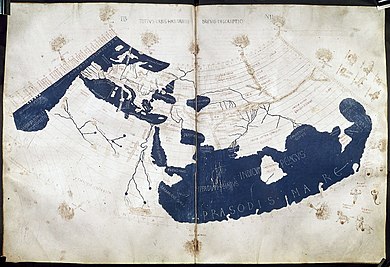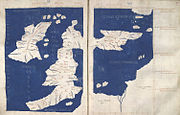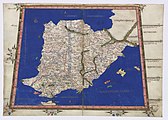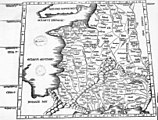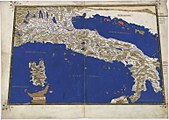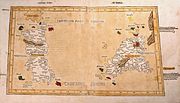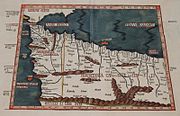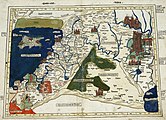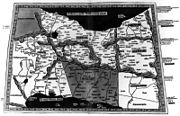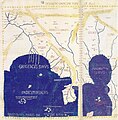Geography (Ptolemy)
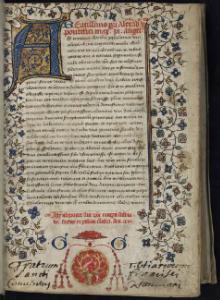
The Geography (
Manuscripts
Versions of Ptolemy's work in antiquity were probably proper
No
The first Latin translation of these texts was made in 1406 or 1407 by Jacobus Angelus in Florence, Italy, under the name Geographia Claudii Ptolemaei.[12] It is not thought that his edition had maps,[13] although Manuel Chrysoloras had given Palla Strozzi a Greek copy of Planudes's maps in Florence in 1397.[14]
| Repository and Collection Number | Date | Maps | Image |
|---|---|---|---|
| Vatican Library, Vat. Gr. 191[15] | 12th-13th century | No extant maps | |
| Copenhagen University Library, Fragmentum Fabricianum Graecum 23[15] | 13th century | Fragmentary; originally world and 26 regional | |
| Vatican Library, Urbinas Graecus 82[15] | 13th century | World and 26 regional | 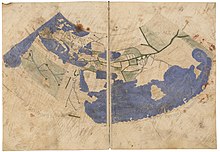
|
| Istanbul Sultan's Library, Seragliensis 57[15] | 13th century | World and 26 regional (poorly preserved) | 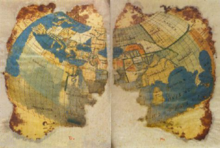
|
| Vatican Library, Vat. Gr. 177[15] | 13th century | No extant maps | |
| Laurentian Library, Plut. 28.49[15] | 14th century | Originally world, 1 Europe, 2 Asia, 1 Africa, 63 regional (65 maps extant) | |
| Bibliothèque nationale de France, Gr. Supp. 119[15] | 14th century | No extant maps | |
| Vatican Library, Vat. Gr. 178[15] | 14th century | No extant maps | |
| British Library, Burney Gr. 111[15] | 14th-15th century | Maps derived from Florence, Pluto 28.49 | |
| Bodleian Library, 3376 (46)-Qu. Catal. i (Greek), Cod. Seld. 41[15] | 15th century | No extant maps | |
| Vatican Library, Pal. Gr. 388[15] | 15th century | World and 63 regional No extant maps | |
| Laurentian Library, Pluto 28.9 (and related manuscript 28.38)[15] | 15th century | No extant maps | |
| Biblioteca Marciana, Gr. 516[15] | 15th century | Originally world and 26 regional (world map, 2 maps, and 2 half maps missing) | |
| Vatican Library, Pal. Gr. 314[15] | 15th century | No extant maps; written by Michael Apostolios in Crete | |
| British Library, Harley MS 3686 | 15th century | 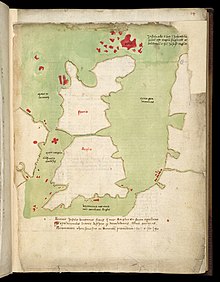
| |
| Huntington Library, Wilton Codex[16] | 15th century | One world, ten of Europe, four of Africa, and twelve of Asia, elegantly coloured and illuminated with burnished gold. |
Contents
The Geography consists of three sections, divided among 8 books. Book I is a treatise on
Cartographical treatise
Maps based on scientific principles had been made in Europe since the time of Eratosthenes in the 3rd century BC. Ptolemy improved the treatment of map projections.[17] He provided instructions on how to create his maps in the first section of the work.
Gazetteer
The gazetteer section of Ptolemy's work provided
Ptolemy was aware that Europe knew only about a quarter of the globe.[citation needed]
Atlas
Ptolemy's work included a single large and less detailed world map and then separate and more detailed regional maps. The first Greek manuscripts compiled after Maximus Planudes's rediscovery of the text had as many as 64 regional maps.[b] The standard set in Western Europe came to be 26: 10 European maps, 4 African maps, and 12 Asian maps. As early as the 1420s, these canonical maps were complemented by extra-Ptolemaic regional maps depicting, e.g., Scandinavia.
Content
An outline of the encyclopedia follows,[22] with links to the appropriate Wikipedia article.
Book 1
Book 2
| Chapter | Region |
|---|---|
| Prologue | |
| 1 | Britannia: Hibernia |
| 2 | Britannia: Albion |
| 3 | Hispanic Baetica |
| 4 | Hispanic Tarraconensis |
| 5 | Hispanic Lusitania
|
| 6 | Aquitanian Gaul |
| 7 | Belgic Gaul |
| 8 | Belgic Gaul
|
| 9 | Narbonensian Gaul
|
| 10 | Greater Germania |
| 11 | Raetia and Vindelica |
| 12 | Noricum |
| 13 | Upper Pannonia |
| 14 | Lower Pannonia |
| 15 | Illyria or Liburnia and Dalmatia |
Book 3
| Chapter | Region |
|---|---|
| 1 | Italy |
| 2 | Corsica |
| 3 | Sardinia |
| 4 | Sicily |
| 5 | Sarmatia |
| 6 | Tauric Peninsula |
| 7 | Iazyges Metanastae
|
| 8 | Dacia |
| 9 | Upper Moesia |
| 10 | Lower Moesia |
| 11 | Peloponnesian Peninsula
|
| 12 | Macedonia |
| 13 | Epirus |
| 14 | Achaia |
| 15 | Crete |
Book 4
| Chapter | Region |
|---|---|
| 1 | Mauritania Tingitana
|
| 2 | Mauritania Caesariensis
|
| 3 | Numidia and Africa proper |
| 4 | Cyrenaica |
| 5 | Marmarica, which is properly called Libya, All of Egypt, both Lower and Upper |
| 6 | Libya Interior |
| 7 | Ethiopia below Egypt |
| 8 | Ethiopia in the interior below this |
Book 5
| Chapter | Region |
|---|---|
| 1 | Bithynia and Pontus |
| 2 | Asia |
| 3 | Lycia |
| 4 | Pamphylia |
| 5 | Galatia |
| 6 | Cappadocia |
| 7 | Cilicia |
| 8 | Asiatic Sarmatia |
| 9 | Colchis |
| 10 | Iberia |
| 11 | Albania |
| 12 | Greater Armenia |
| 13 | Cyprus |
| 14 | Syria |
| 15 | Palestine |
| 16 | Arabia Petraea |
| 17 | Mesopotamia |
| 18 | Arabia Deserta |
| 19 | Babylonia |
Image Gallery
-
TheCattigara) at the extreme right beyond the island of "Taprobane" (Sri Lanka) and the "Aurea Chersonesus" (Malay Peninsula).
-
Baetica, and Lusitania
-
Belgica
-
Cimbric Peninsula
-
Corsica
-
Sardinia and Sicily
-
Peloponnesus, and Crete
-
Caesarian Mauritania
-
Lower Egypt, and the Thebaid
-
Cappadocia, Cilicia, and Lesser Armenia
-
Iberia, Albania, and Greater Armenia
-
-
Carmania Deserta
-
Carmania Deserta
-
Sacae
-
Paropanisus
-
Sinae
History
Antiquity
The original treatise by
Whereas previous Greco-Roman geographers such as
Medieval Islam

Despite beginning to compile numerous gazetteers of places and coordinates indebted to Ptolemy,[37] Muslim scholars made almost no direct use of Ptolemy's principles in the maps which have survived.[31] Instead, they followed al-Khwārazmī's modifications and the orthogonal projection advocated by Suhrāb's early 10th-century treatise on the Marvels of the Seven Climes to the End of Habitation. Surviving maps from the medieval period were not done according to mathematical principles. The world map from the 11th-century Book of Curiosities is the earliest surviving map of the Muslim or Christian worlds to include a geographic coordinate system but the copyist seems to have not understood its purpose, starting it from the left using twice the intended scale and then (apparently realizing his mistake) giving up halfway through.[38] Its presence does strongly suggest the existence of earlier, now-lost maps which had been mathematically derived in the manner of Ptolemy,[33] al-Khwārazmi, or Suhrāb. There are surviving reports of such maps.[37]
Ptolemy's Geography was translated from Arabic into Latin at the court of King Roger II of Sicily in the 12th century AD.[39] However, no copy of that translation has survived.
Renaissance
The Greek text of the Geography reached Florence from Constantinople in about 1400 and was translated into Latin by Jacobus Angelus of Scarperia around 1406.[12] The first printed edition with maps, published in 1477 in Bologna, was also the first printed book with engraved illustrations.[40][41] Many editions followed (more often using woodcut in the early days), some following traditional versions of the maps, and others updating them.[40] An edition printed at Ulm in 1482 was the first one printed north of the Alps. Also in 1482, Francesco Berlinghieri printed the first edition in vernacular Italian.

Ptolemy had mapped the whole world from the Fortunatae Insulae (
Catigara is also shown at this location on Martin Waldseemüller's 1507 world map, which avowedly followed the tradition of Ptolemy. Ptolemy's information was thereby misinterpreted so that the coast of China, which should have been represented as part of the coast of eastern Asia, was falsely made to represent an eastern shore of the Indian Ocean. As a result, Ptolemy implied more land east of the 180th meridian and an ocean beyond.
The Codex Seragliensis was used as the base of a new edition of the work in 2006.
Influence on Christopher Columbus
Early modern Ottoman Empire
Prior to the 16th century, knowledge of geography in the
Longitudes error and Earth size
There are two related errors:[51]
- Considering a sample of 80 cities amongst the 6345 listed by Ptolemy, those that are both identifiable and for which we can expect a better distance measurement since they were well known, there is a systematic overestimation of the longitude by a factor 1.428 with a high confidence (coefficient of determination r² = 0.9935). This error produces evident deformations in Ptolemy's world map most apparent for example in the profile of Italy, which is markedly stretched horizontally.
- Ptolemy accepted that the known Ecumene spanned 180° of longitude, but instead of accepting Eratosthenes's estimate for the circumference of the Earth of 252,000 stadia, he shrinks it to 180,000 stadia, with a factor of 1.4 between the two figures.
This suggests Ptolemy rescaled his longitude data to fit with a figure of 180,000 stadia for the circumference of the Earth, which he described as a "general consensus".[51] Ptolemy rescaled experimentally obtained data in many of his works on geography, astrology, music, and optics.
Gallery
-
Codex Seragliensis GI 57, fol. 33v
-
Scandinavia in theZamoyski Codex(c. 1467)
-
1535 printed edition, title page
-
19th-century print in Greek (3 volumes)
-
Prima Europe tabula One of the earliest surviving copies of Ptolemy's 2nd-century map of Great Britain and Ireland. 2nd edition, 1482.
-
Sebastian Munster, Tabula Sarmatiae, 1571
-
Sebastian Munster, Tabula Sarmatiae, 1571 (reverse)
See also
- Almagest, Ptolemy's astronomical work
- Description of Greece
- Bibliotheca historica
- Diodorus Siculus
- Geography and cartography in medieval Islam
- Strabo
- List of most expensive books and manuscripts
Notes
- ^ They are the Urbanas Graecus 82,[6] the Fragmentum Fabricianum Graecum 23,[7] and the Seragliensis 57.[8] The Urbanas Graecus is usually considered the oldest,[9][10] although some argue for the precedence of the Turkish manuscript.[11]
- ^ For example, the illustrations for British Library, Burney MS 111,[21] most of which were inserted into an earlier copy of the Geography during the early 15th century.
Citations
- ^ Berggren (2000).
- ^ Dilke (1987b), pp. 267–268.
- ^ a b c Dilke (1987b), p. 268.
- ^ Biblioteca Apostolica Vaticana [The Apostolic Vatican Library]. Vat. Gr. 177. Late 13th century
- ^ Milanesi (1996).
- ^ Biblioteca Apostolica Vaticana [The Apostolic Vatican Library]. Urbinas Graecus 82. Late 13th century
- ^ Universitetsbiblioteket [The University Library of Copenhagen]. Fragmentum Fabricianum Graecum 23. Late 13th century
- ^ The Sultan's Library in Istanbul. Codex Seragliensis GI 57. Late 13th century
- ^ Dilke (1987b), p. 269.
- ^ Diller (1940).
- ^ a b Stückelberger (2006).
- ^ a b Angelus (c. 1406).
- ^ Clemens (2008), p. 244.
- ISBN 978-0-8018-8589-1.
- ^ a b c d e f g h i j k l m n Oswald A. W. Dilke, "The Culmination of Greek Cartography in Ptolemy," in J. B. Harley and David Woodward, The History of Cartography, volume one. Cartography in Prehistoric, Ancient, and Medieval Europe and the Mediterranean. Chicago: The University of Chicago Press, 1987, pp. 177-200.
- ^ "Ptolemy, Geographia : cartographic material : manuscript". The Huntington Library. 1475. Retrieved 2022-09-07.
- ISBN 9780226767475.
- ^ Talbert, Richard (2017). Roman Portable Sundials: The Empire in Your Hand. Oxford University Press. pp. 119–123.
- ^ Wright (1923).
- ISBN 978-0-7503-1194-6.
- ^ Images from Burney MS 111 at Wikicommons.
- ^ Thayer, Bill. "Ptolemy: the Geography". Lacus Curtius. University of Chicago. Retrieved 13 April 2023.
- ^ "Ptolemy's World Map". www.bl.uk. Retrieved 2020-01-15.
- ^ a b Dilke (1987a), p. 234.
- ^ Codex Athous Vatopedinus 655: Add MS 19391, f 19v-20 (British Library, London)
- ^ a b Parker (2008), p. 118.
- ^ Young (2001), p. 29.
- ^ Mawer (2013), p. 38.
- ^ Suárez (1999), p. 90-92.
- ^ Yule (1915), p. 52.
- ^ a b Edson (2004), pp. 61–62.
- ^ a b c d Rapoport (2008), p. 128.
- ^ a b Rapoport (2008), p. 127.
- ^ Nallino (1939).
- ^ al-Masʿūdī 1894, 33.
- ^ Rapoport (2008), p. 130.
- ^ a b Rapoport (2008), p. 129.
- ^ Rapoport (2008), p. 126–127.
- ISBN 9789004347380.
- ^ ISBN 978-0-300-06883-2.
- JSTOR 1792324.
- ISSN 1041-5440.
- ^ J.W. McCrindle, Ancient India as described by Ptolemy, London, Trubner, 1885, revised edition by Ramachandra Jain, New Delhi, Today & Tomorrow’s Printers & Publishers, 1974, p.204: “By the Great Gulf is meant the Gulf of Siam, together with the sea that stretches beyond it toward China”; Albert Herrmann, “Der Magnus Sinus und Cattigara nach Ptolemaeus”, Comptes Rendus du 15me Congrès International de Géographie, Amsterdam, 1938, Leiden, Brill, 1938, tome II, sect. IV, Géographie Historique et Histoire de la Géographie, pp.123-8.[1]
- ^ Paul Schnabel, „Die Entstehungsgeschichte des kartographischen Erdbildes des Klaudios Ptolemaios“, Sitzungsberichte der Preussischen Akademie der Wissenschaften: Philosophisch-Historische Klasse, Verlag der Akademie der Wissenschaften, Bd.XIV, 1930, S.214-250, n.b. 239-243; cited in Albert Herrmann, “South-Eastern Asia on Ptolemy’s Map”, Research and Progress: Quarterly Review of German Science, vol.V, no.2, March–April 1939, pp.121-127, p.123.
- ISBN 978-3-534-23757-9.
- ISBN 978-3-534-24835-3.
- ISBN 978-3-8442-2809-0.
- ^ “Alberico”, vol.IV, c. 169, Florence, Biblioteca Nazionale Centrale, Banco Rari 234; Sebastian Crino, "Schizzi cartografici inediti dei primi anni della scoperta dell' America", Rivista marittima, vol. LXIV, no.9, Supplemento, Novembre 1930, p.48, fig.18. Downloadable at: https://www.henry-davis.com/MAPS/Ren/Ren1/304.1.html Archived 2018-06-15 at the Wayback Machine
- ^ Casale, Giancarlo (2003). The Ottoman 'Discovery' of the Indian Ocean in the Sixteenth Century: The Age of Exploration from an Islamic Perspective.
- ^ Brotton, Jerry. Trading Territories: Mapping the Early Modern World. p. 101. Archived from the original on 2016-04-06.
- ^ .
References
- Ptolemy. Translated by Jacobus Angelus (c. 1406), Geographia. (in Latin)
- Berggren, J. Lennart & Alexander Jones (2000), Ptolemy's Geography: An Annotated Translation of the Theoretical Chapters, Princeton: Princeton University Press, ISBN 978-0-691-09259-1.
- Clemens, Raymond (2008), "Medieval Maps in a Renaissance Context: Gregorio Dati", in Talbert, Richard J.A.; Unger, Richard Watson (eds.), Cartography in Antiquity and the Middle Ages: Fresh Perspectives, New Methods, Leiden: Koninklijke Brill NV, pp. 237–256
- Dilke, Oswald Ashton Wentworth (1987a), "14 · Itineraries and Geographical Maps in the Early and Late Roman Empires"(PDF), History of Cartography, vol. I, Chicago: University of Chicago Press, pp. 234–257.
- Dilke, Oswald Ashton Wentworth (1987b), "15 · Cartography in the Byzantine Empire"(PDF), History of Cartography, vol. I, Chicago: University of Chicago Press, pp. 258–275.
- Diller, Aubrey (1940), "The Oldest Manuscripts of Ptolemaic Maps", Transactions of the American Philological Association, pp. 62–67.
- Edson, Evelyn & al. (2004), Medieval Views of the Cosmos, Oxford: Bodleian Library, ISBN 978-1-85124-184-2.
- al-Masʿūdī(1894), "Kitāb al-Tanbīh wa-al-ishrāf", Bibliotheca Geographorum Arabicorum, vol. 8, Leiden: Brill.
- Mawer, Granville Allen (2013). "The Riddle of Cattigara". In Nichols, Robert and Martin Woods (ed.). Mapping Our World: Terra Incognita to Australia. National Library of Australia. pp. 38–39. ISBN 9780642278098.
- Milanesi, Marica (1996), "A Forgotten Ptolemy: Harley Codex 3686 in the British Library", .
- Nallino, C.A.(1939), "Al-Ḥuwārismī e il suo rifacimento della Geografia di Tolomeo", Raccolta di scritti editi e inediti, vol. V, Rome: Istituto per l'Oriente, pp. 458–532. (in Italian)
- Parker, Grant (2008). The Making of Roman India. Cambridge University Press. ISBN 978-0-521-85834-2.
- Peerlings, Robert; Laurentius, Frans; van den Bovenkamp, Jaap (2017), "The watermarks in the Rome editions of Ptolemy's Cosmography and more", .
- Peerlings, Robert; Laurentius, Frans; van den Bovenkamp, Jaap (2018), "New findings and discoveries in the 1507/8 Rome edition of Ptolemy's Cosmography", S2CID 165379448.
- Rapoport, Yossef; et al. (2008), "The Book of Curiosities and a Unique Map of the World", Cartography in Antiquity and the Middle Ages: Fresh Perspectives, New Methods, Leiden: Koninklijke Brill NV, pp. 121–138.
- Stückelberger, Alfred & al., eds. (2006), Ptolemaios Handbuch der Geographie (Griechisch-Deutsch) [Ptolemy's Manual on Geography (Greek/German)], Schwabe, ISBN 978-3-7965-2148-5. (in German and Greek)
- Suárez, Thomas (1999), Early Mapping of Southeast Asia, Periplus Editions, ISBN 978-962-593-470-9.
- Wright, John Kirtland (1923), "Notes on the Knowledge of Latitudes and Longitudes in the Middle Ages", Isis, V (1): 75–98, S2CID 143159033.
- Young, Gary Keith (2001). Rome's Eastern Trade: International Commerce and Imperial Policy, 31 BC-AD 305. Routledge. ISBN 978-0-415-24219-6.
- Yule, Henry (1915). Henri Cordier (ed.). Cathay and the Way Thither: Being a Collection of Medieval Notices of China, Vol I: Preliminary Essay on the Intercourse Between China and the Western Nations Previous to the Discovery of the Cape Route. Vol. 1. Hakluyt Society.
Further reading
- Blažek, Václav. "Etymological Analysis of Toponyms from Ptolemy's Description of Central Europe". In: Studia Celto-Slavica 3 (2010): 21–45. DOI: https://doi.org/10.54586/GTQF3679.
- Blažek, Václav. "The North-Eastern Border of the Celtic World". In: Studia Celto-Slavica 8 (2018): 7–21. DOI: https://doi.org/10.54586/ZMEE3109.
- Cosgrove, Dennis. 2003. Apollo's Eye: A Cartographic Genealogy of the Earth in the Western Imagination. Johns Hopkins University Press. Baltimore and London.
- Gautier Dalché, Patrick. 2009. La Géographie de Ptolémée en Occident (IVe-XVIe siècle). Terratum Orbis. Turnhout. Brepols, .
- Shalev, Zur, and Charles Burnett, eds. 2011. Ptolemy's Geography in the Renaissance. London; Turin. Warburg Institute; Nino Aragno. (In Appendix: Latin text of Jacopo Angeli's introduction to his translation of the Geography, with English translation by C. Burnett.)
- Stevenson, Edward Luther. Trans. and ed. 1932. Claudius Ptolemy: The Geography. New York Public Library. Reprint: Dover, 1991. This is the only complete English translation of Ptolemy's most famous work. Unfortunately, it is marred by numerous mistakes (see Diller) and the place names are given in Latinised forms, rather than in the original Greek.
- Diller, Aubrey (February 1935). "Review of Stevenson's translation". Isis. 22 (2): 533–539. doi:10.1086/346925. Retrieved 2007-07-15.
External links
Primary sources
- Greek
- Klaudios Ptolemaios: Handbuch der Geographie, hrsg. von Alfred Stückelberger und Gerd Grasshoff (Basel: Schwabe, 2006)
- (in Greek) Claudii Ptolemaei Geographia, ed. Karl Friedrich August Nobbe, Sumptibus et typis Caroli Tauchnitii, 1843, tom. I (books 1–4, missing p. 126); 1845, tom. II (books 5–8); 1845, tom. III (indices).
- Latin
- (in Latin) La Cosmographie de Claude Ptolemée, Latin manuscript copied around 1411
- (in Latin) Geography, digitized codex made in Italy between 1460 and 1477, translated to Latin by Jacobus Angelus at Somni. Also known as codex valentinus, it is the oldest manuscript of the codices with maps of Ptolemy with the donis projections.
- (in Latin) "Cosmographia" / Claudius Ptolemaeus. Translated into Latin by Jacobus Angelus, and edited by Nicolaus Germanus. – Ulm : Lienhart Holle. – 1482. (In the National Library of Finland.)
- (in Latin) Geographia Universalis, Basileae apud Henricum Petrum mense Martio anno M. D. XL. [of Basel, printed by Henricus Petrus in the month of March in the year 1540].
- (in Latin) Geographia Cl. Ptolemaei Alexandrini, Venetiis : apud Vincentium Valgrisium, Venezia, 1562.
- Italian
- (in Italian) Geografia cioè descrittione vniuersale della terra partita in due volumi..., In Venetia : appresso Gio. Battista et Giorgio Galignani fratelli, 1598.
- (in Italian) Geografia di Claudio Tolomeo alessandrino, In Venetia : appresso gli heredi di Melchior Sessa, 1599.
- English
- Ptolemy's Geography at LacusCurtius (English translation)
- Extracts of Ptolemy on the country of the Seres (China) (English translation)
- 1st critical edition of Geography Book 8, by Aubrey Diller
- Geography Books 2.10-6.11 in English, with most Greece-related places geolocated, by John Brady Kiesling at ToposText
Secondary material
- Ptolemy the Geographer
- Ptolemy's Geography of Asia – Selected problems of Ptolemy's Geography of Asia (in German)
- History of Cartography Archived 2011-09-27 at the Wayback Machine including a discussion of the Geographia
- [ http://www.e-perimetron.org/Vol_18_4/Gusev_Stafeyev.pdf Claudius Ptolemy’s East Africa Georeferenced and Visualized ]

